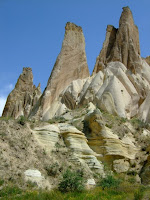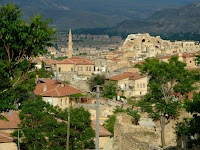 We later learned that we were in the provincial capital of Nevsehir. The bus officials were asking questions which we either did not understand, or if we did, did not know the answer to. As we were trying desperately to match words we were hearing with words on our itinerary, a helpful young man appeared on the bus saying our name. He was the local agent and had come to this place to ensure that we stayed on the bus until our final destination of Urgup. Once there, he took us to our hotel to give us a chance to freshen up and change for the day ahead.
We later learned that we were in the provincial capital of Nevsehir. The bus officials were asking questions which we either did not understand, or if we did, did not know the answer to. As we were trying desperately to match words we were hearing with words on our itinerary, a helpful young man appeared on the bus saying our name. He was the local agent and had come to this place to ensure that we stayed on the bus until our final destination of Urgup. Once there, he took us to our hotel to give us a chance to freshen up and change for the day ahead. The bus that collected us from our hotel had an Aussie and two Canadians on board and we added to the collection from the Colonies to complete the small group for the day who set off to explore this part of Capadoccia. A UNESCO World Heritage site since the 50s, this area is characterised by the soft pumice ash layers which, in conjunction with occasional basalt topping combine to create fantasy shapes known locally as Fairy Chimneys. The trace minerals colour the layers green, red and purple and the hard basalt topping protects the softer pumice below from the weathering effects of the elements.
The bus that collected us from our hotel had an Aussie and two Canadians on board and we added to the collection from the Colonies to complete the small group for the day who set off to explore this part of Capadoccia. A UNESCO World Heritage site since the 50s, this area is characterised by the soft pumice ash layers which, in conjunction with occasional basalt topping combine to create fantasy shapes known locally as Fairy Chimneys. The trace minerals colour the layers green, red and purple and the hard basalt topping protects the softer pumice below from the weathering effects of the elements. We were dropped at the top of Rose Valley and enjoyed a 4km stroll down to Cavusin at the bottom which was oldest Christian settlement in the area. The locals moved out of their rock houses in the 60s and the houses have unfortunately fallen into disrepair as erosion has eaten away walls and ceilings.
We were dropped at the top of Rose Valley and enjoyed a 4km stroll down to Cavusin at the bottom which was oldest Christian settlement in the area. The locals moved out of their rock houses in the 60s and the houses have unfortunately fallen into disrepair as erosion has eaten away walls and ceilings.After lunch we had the obligatory tour group stop to worship at the shrine of commerce, this time in the form of an Onyx and Jewellery factory and shop.
 We drank the hot tea, gazed admiringly and left with our wallets intact heading for the infinitely more interesting Kaymakli Underground City. Discovered only comparatively recently this is an amazing network of streets, rooms and passages carved out of the soft layers of ash. Built as a defensive hiding place, this city once housed 5000 people and has a passage running 9km underground to another similar underground warren, Derinkuyu.
We drank the hot tea, gazed admiringly and left with our wallets intact heading for the infinitely more interesting Kaymakli Underground City. Discovered only comparatively recently this is an amazing network of streets, rooms and passages carved out of the soft layers of ash. Built as a defensive hiding place, this city once housed 5000 people and has a passage running 9km underground to another similar underground warren, Derinkuyu.Our last call was Mustafapasa where there are many dwellings made from or cut into the Tufa rock. It looked very similar to Matera in Italy, albeit on a smaller and possibly scruffier scale.
 The Yasemin Cave Hotel, a decent climb above the centre of Urgup, afforded us a great view of the surrounding area and the gathering thunderclouds that eventually unleashed their pent up energy. If you are in this area, we recommend staying at this delightful little family-run hotel.
The Yasemin Cave Hotel, a decent climb above the centre of Urgup, afforded us a great view of the surrounding area and the gathering thunderclouds that eventually unleashed their pent up energy. If you are in this area, we recommend staying at this delightful little family-run hotel.




1 comment:
Great pictures Murray - you sure had a great time.
Esther
Post a Comment